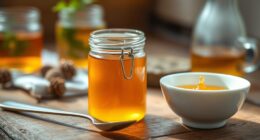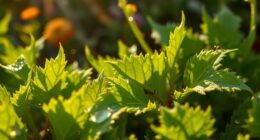Diverse bee colonies offer significant benefits, enhancing both resilience and productivity. By mixing different races, you're improving the genetic pool, which leads to greater disease resistance and adaptability to environmental changes. Each bee race presents unique traits suited to specific climates, so understanding these differences can optimize your beekeeping efforts. Naming conventions help you identify and manage these races effectively, preserving traditional knowledge and best practices. Overall, embracing diversity in your colonies can result in healthier hives and increased honey production. If you're curious about specific bee traits or how to implement these practices, there's more to uncover.
Key Takeaways
- Increased genetic diversity from mixing bee races enhances resilience and adaptability to diseases and environmental changes.
- Hybridization improves foraging efficiency and overall productivity in honey bee colonies.
- Specific naming conventions, like Carnica and Ligustica, help differentiate bee races and their unique traits.
- Local environmental factors significantly influence the success and adaptability of mixed bee colonies.
- Community knowledge and practices strengthen breeding efforts, promoting disease resistance and productivity tailored to local conditions.
Importance of Genetic Diversity
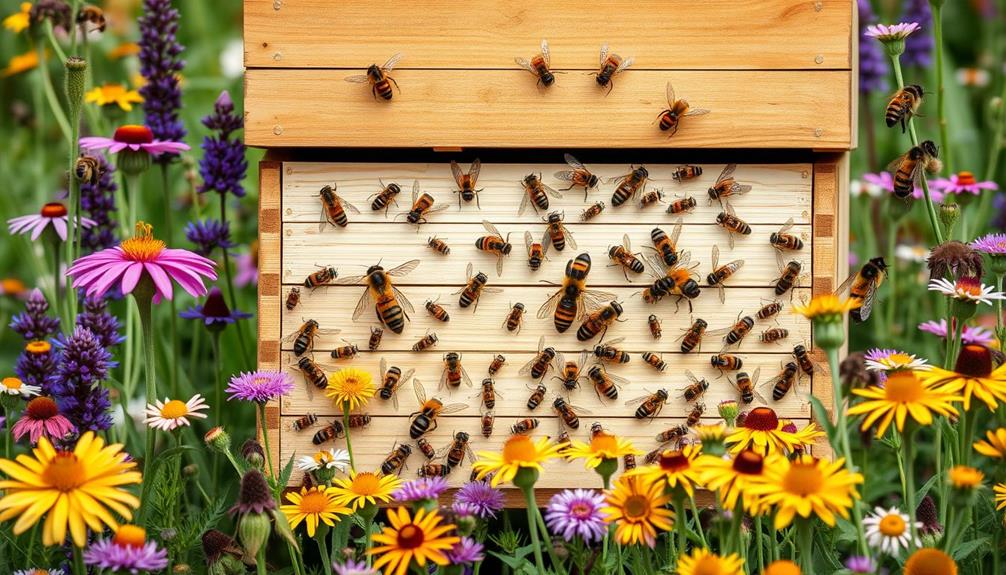
Why is genetic diversity so crucial for bee colonies? Genetic diversity within honey bee populations greatly boosts their resilience and adaptability. When you have a mix of drone populations nearby, it enhances the genetic pool, allowing colonies to better withstand environmental changes and diseases. This diversity isn't just a random perk; it directly impacts the health and productivity of your hives.
Additionally, common honey bee species in your area can contribute to local adaptation and resilience, making it essential to understand the traits of these bees.
Breeding programs and local practices often lead to mixed breed colonies, which can showcase various favorable traits. You'll find that hybridization can improve disease resistance and foraging efficiency, making your colonies not only stronger but also more productive in honey production.
The presence of multiple bee races in a single area fosters improved mating outcomes for queens, contributing to healthier colonies overall.
As a beekeeper, understanding the genetic traits of different bee races allows you to select the best stock for your specific conditions. This knowledge optimizes your local beekeeping success, ensuring your hives thrive in their environment.
Major Honey Bee Races

When you explore the major races of honey bees, you'll notice each one has distinct characteristics that make them suited for different environments.
For instance, the gentle Carnica thrives in colder climates, while the Italian Bee is renowned for its robust honey production.
Understanding these traits helps you choose the right race for your local conditions, enhancing your colony's health and productivity.
Additionally, considering factors like investment regulations can also play a vital role in your decision-making process, ensuring you create a sustainable and successful beekeeping venture.
Characteristics of Major Races
Honey bees come in various races, each with distinct characteristics that influence their behavior and productivity. Understanding these traits can help you choose the right bees for your apiary.
| Honey Bee Race | Key Characteristics | Ideal Conditions |
|---|---|---|
| Carnica (Apis mellifera carnica) | Gentle, productive, thrives in cold winters | Cooler climates |
| Dark European Bee (Apis mellifera mellifera) | Larger size, more disease-prone | Moderate climates |
| Caucasian Bees (Apis mellifera caucasia) | Excellent nectar gatherers, prone to robbing | Flower-rich environments |
| Italian Bees (Apis mellifera ligustica) | Strong honey production, hygienic behavior | Warm climates with good forage |
Each race holds unique benefits. The Carnica bee is ideal if you're in a colder region, while Italian bees are favored for their honey yield. The Dark European bee, though larger, requires more careful management due to its susceptibility to disease. Finally, Caucasian bees might excel in nectar gathering but could pose challenges with robbing behavior. Selecting the right race can greatly impact your beekeeping success!
Adaptability to Environments
Understanding the adaptability of various honey bee races to different environments is vital for successful beekeeping. For instance, if you live in a colder climate, the Carnica honey bee (Apis mellifera carnica) is an excellent choice. Its ability to survive harsh winters and gentle temperament make it particularly suitable for these regions.
Additionally, considering the importance of environmental factors in bee health and productivity is essential, as highlighted by recent studies on cold medications overview.
Conversely, the Dark European bee (Apis mellifera mellifera) possesses strong foraging abilities, yet its vulnerability to diseases can limit its effectiveness in certain settings.
If you're looking for bees that excel in nectar gathering, consider Caucasian bees (Apis mellifera caucasia). They're known for their foraging skills, but be cautious about potential robbing behaviors.
On the other hand, Italian bees (Apis mellifera ligustica) are celebrated globally for their high honey yield and hygienic traits, making them versatile across various agricultural environments.
Ultimately, each major honey bee race has unique characteristics that directly impact their adaptability. By understanding these traits, you can make informed decisions that enhance your beekeeping success and optimize your colony's performance in your specific environment.
Benefits of Hybridization
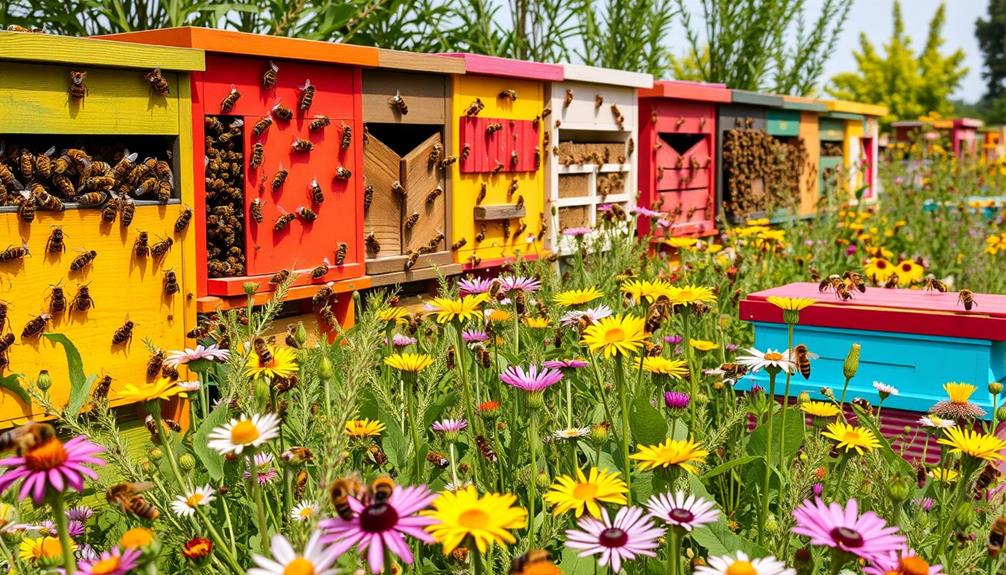
When you consider hybridization in honey bees, you'll see it markedly boosts disease resistance and enhances foraging efficiency.
These hybrids often outperform purebred bees, making them more resilient and productive in the face of challenges like pests.
Enhanced Disease Resistance
Diverse bee colonies, especially those formed through hybridization, show remarkable enhanced disease resistance. When you crossbreed different bee races, you increase genetic diversity, which equips the colonies to better combat threats like Varroa mites and tracheal mites. Significantly, Russian Bees have been specifically bred to tackle these pests, demonstrating the effectiveness of targeted hybridization.
Here's a quick comparison of hybrid bees versus pure strains regarding disease resistance:
| Trait | Hybrid Bees | Pure Strains |
|---|---|---|
| Disease Resistance | High | Moderate |
| Genetic Diversity | Increased | Limited |
| Mortality Rates | Lower | Higher |
Improved Foraging Efficiency
Improved foraging efficiency is one of the standout benefits of hybridizing bee colonies. When you mix different honey bee races, you often see enhanced adaptability to local environmental conditions. This genetic diversity can make your colonies more effective foragers, as they develop varied temperaments that positively influence their foraging behavior.
With this mix, your bees can exploit a wider range of floral resources, optimizing honey production.
Research shows that hybrid bees, like Russian and Buckfast varieties, exhibit improved foraging efficiency. These hybrids also demonstrate higher resilience to diseases, which indirectly boosts foraging capabilities. A healthy colony means a stronger workforce that can gather more resources.
Moreover, the increased genetic diversity from hybridization expands the range of foraging strategies and preferences among worker bees. This means your bees can adapt more quickly to changing conditions and find food sources that may have otherwise gone unexploited.
Breeding Practices and Traits
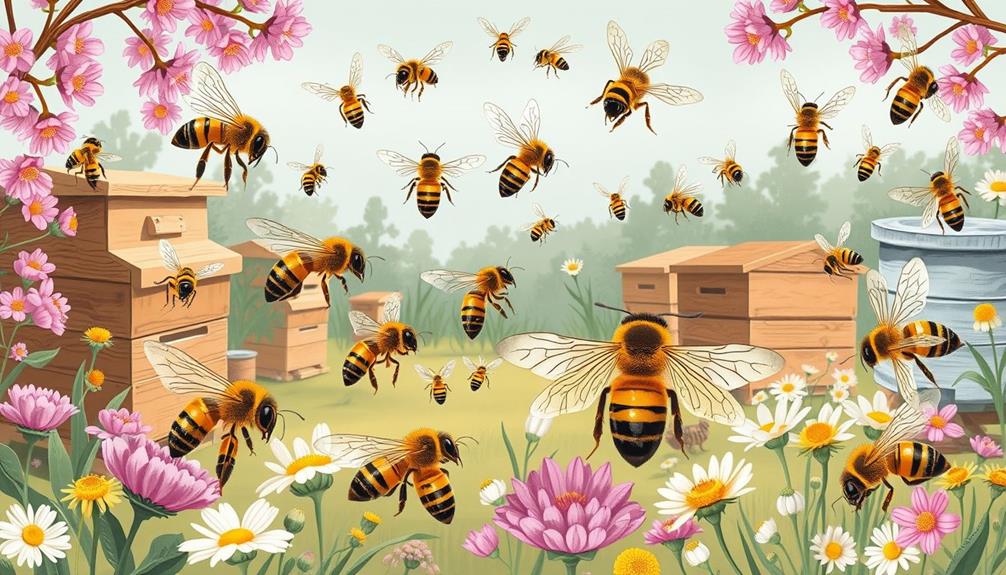
Breeding practices for honey bees play an essential role in enhancing specific traits that are important for successful apiculture. You'll find that breeding programs focus on improving gentleness, productivity, and disease resistance through controlled mating environments.
Specialized breeding associations often utilize controlled mating stations to preserve pure strains of honey bees while promoting characteristics that align with local conditions.
The success of specific races in your area can greatly depend on local preferences among beekeepers and regional environmental factors.
Hybridization can be a game-changer, boosting disease resistance and genetic diversity, which in turn improves foraging efficiency and overall colony strength.
However, you should be aware that maintaining hybrid vigor while managing undesirable traits presents a challenge. Careful selection and monitoring of bee populations are vital in this process.
Naming Conventions in Beekeeping
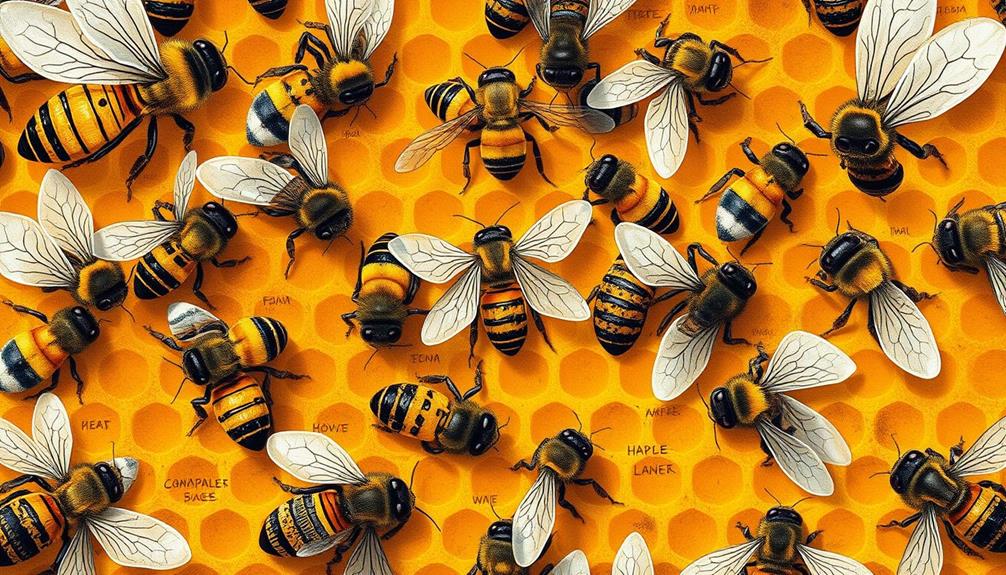
In the world of beekeeping, naming conventions hold significant importance for both practical and cultural reasons. You'll discover a rich array of specialized terms that reflect the diverse practices across different regions.
For instance, the German language adds a poetic touch to the terminology, capturing the artistry of bee behavior and management. Specific names for bee races, like Carnica for the Carniolan bee and Ligustica for the Italian bee, help you differentiate their unique traits and adaptations. This clarity is essential when you're selecting the right race for your beekeeping goals.
Terms such as "Abtrommeln von Bienen" precisely describe techniques you might use in managing your colonies, emphasizing the care involved in beekeeping. As you explore deeper into beekeeping, you'll notice how naming conventions not only preserve traditional knowledge but also evolve to address modern challenges.
This continuous updating guarantees that you stay informed about best practices while honoring the heritage passed down through generations. By understanding these naming conventions, you'll enhance your beekeeping experience and contribute to the broader community of enthusiasts and professionals alike.
Environmental Adaptability

Many beekeepers recognize the importance of environmental adaptability when it comes to maintaining healthy colonies. Diverse bee populations, achieved through mixing races, boost genetic resilience and adaptability to varying environmental conditions.
For instance, Carniolan bees are well-suited for colder winters, while Italian bees thrive in warmer climates. This diversity allows you to select the right bees for your local environment.
Hybrid bees often show increased foraging efficiency and adaptability since they combine desirable traits from different races. This means they can better respond to environmental stressors, enhancing their chances of survival.
Furthermore, the presence of nearby drone populations positively influences queen mating outcomes, leading to genetic diversity within your colonies. This diversity is essential for improving overall adaptability.
Regional factors, like local flora availability and climate, greatly shape the success of specific bee races. By maintaining a diverse bee population, you're not just supporting your colonies; you're also cultivating resilience against changes in habitat.
This adaptability can be the key to thriving beekeeping, ensuring your bees flourish in an ever-changing environment.
Challenges in Maintaining Diversity
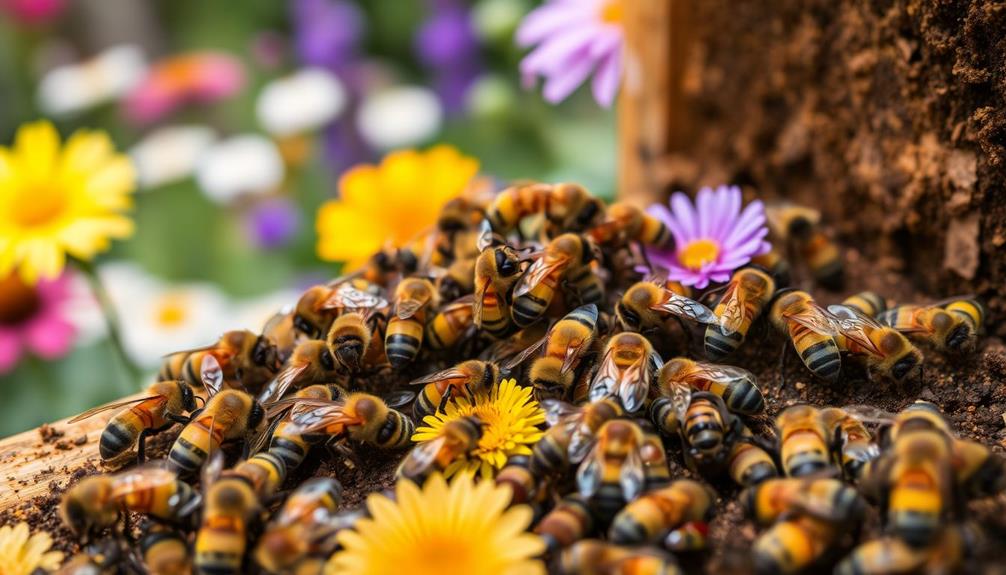
Maintaining genetic diversity in your bee colonies presents several challenges that can complicate effective management. The hybridization of different bee races can lead to unpredictable behavior, such as varied temperaments and increased swarming tendencies. This unpredictability makes it harder for you to manage your colonies effectively. Local conditions and your beekeeping practices greatly influence breeding programs aimed at preserving desirable traits while avoiding inbreeding among pure strains.
Moreover, environmental changes, like pesticide exposure and habitat loss, threaten the survival of diverse bee populations by affecting foraging efficiency. Balancing the introduction of hybrid varieties, such as Russian and Buckfast bees, with the need to maintain desirable characteristics is essential yet complex.
Here's a summary of these challenges:
| Challenge | Impact on Diversity |
|---|---|
| Hybridization | Varied temperaments, swarming |
| Local conditions | Influences breeding effectiveness |
| Environmental changes | Reduces foraging efficiency |
| Disease resistance | Complicates trait preservation |
| Habitat loss | Threatens bee survival |
Community Knowledge and Practices
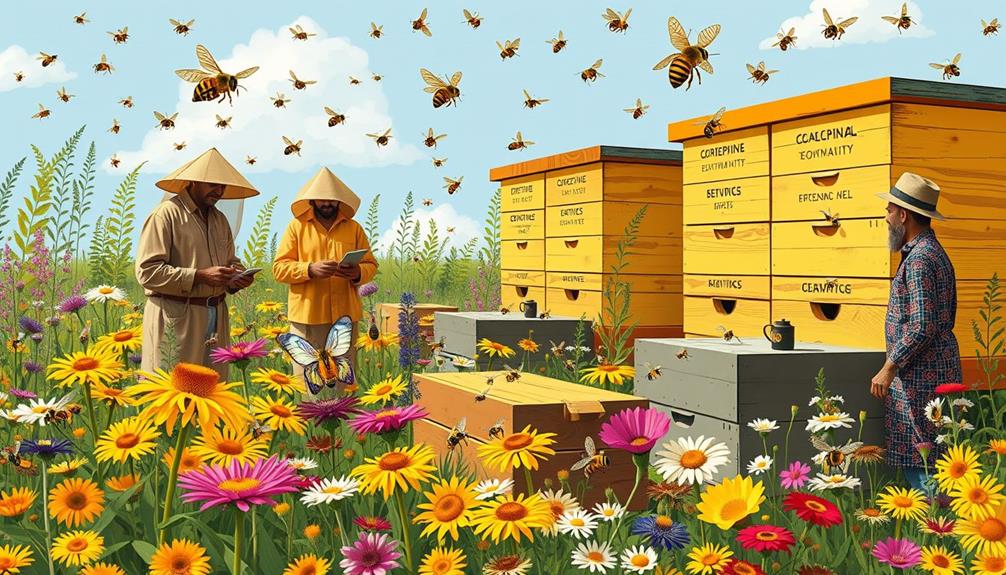
Community knowledge considerably influences how beekeepers manage their colonies, allowing for practices that are finely tuned to local conditions.
You'll find that local imker preferences shape the genetic traits of bee stocks, directly impacting the success and adaptability of your colonies. By tapping into the collective experiences of your community, you can adopt breeding practices that enhance desirable traits like productivity, gentleness, and disease resistance, ensuring your bees thrive in their unique environments.
Understanding the differences among various breeds helps you implement better management practices tailored to the specific needs of your bee populations.
For instance, if your community has insights about certain breeds' resilience to local pests, you can adjust your approach accordingly.
Collaborative efforts within your beekeeping community not only strengthen your individual practices but also build resilience against challenges like disease transmission and environmental changes.
Frequently Asked Questions
Why Buckfast?
If you're considering bees, Buckfast's adaptability and disease resistance make them a smart choice. Their gentle nature makes handling easier, and their impressive honey production guarantees you'll enjoy a fruitful beekeeping experience.
What Is the Difference Between Buckfast and Carnica?
You'll discover that Buckfast bees are like superheroes—adaptable and disease-resistant—while Carnica bees are the gentle giants of honey production. Each has unique strengths, making them perfect for different beekeeping adventures. Choose wisely!
Which Bee Breed Is the Gentlest?
If you're seeking the gentlest bee breed, consider the Italian bee. Its calm nature makes it ideal for beginners. Carnica and Caucasian bees are also gentle, but their temperament can vary based on environmental factors.
Which Bee Species Is the Best?
Choosing the best bee species depends on your specific environment and goals. If you need strong honey production, consider Italians. For gentleness and cold resilience, Carniolans might suit you better. Assess your local conditions first.
Conclusion
Incorporating diverse bee colonies is like cultivating a vibrant garden; each race brings unique strengths that enhance resilience and productivity. By embracing genetic diversity, you not only support healthier hives but also contribute to the overall ecosystem. While challenges exist in maintaining this diversity, the benefits—ranging from increased adaptability to richer honey production—are undeniable. So, as you engage with your bees, remember that a mix of races can create a thriving community, much like nature itself.







